Grounding Ourselves
If you live in a place in the north that experiences significant seasonal changes, the transformation from Winter into Spring is one of the most anticipated and perhaps the most joyful seasonal transition. This year, the Spring Equinox is on either March 19 or 20 depending on your longitude, and as it approaches, we revel in the increase of light and warmth and green.
Tuning into and recognizing familiar patterns of seasonal changes is a pathway for rooting ourselves as a creature into the living world. Our climate is becoming more chaotic and unpredictable, and seasonal patterns are changing, but there are still plenty of signs by which to orient ourselves. In this time of rapid change, I feel that I have a responsibility to be a witness and to remember.
After our winter this year really only amounted to a couple of cold spells that lasted a week or two, the quality of my attentiveness to the living patterns around me has a deeper poignancy. I go out for walks hoping to find familiar seasonal patterns and when I do, a feeling of relief wells up. This has led me to engage even more intentionally in learning about specific kinds of lives and their entanglements that serve collective thriving. I want to speak their names and know their lives as well as I can.
Come with me now, here, to explore and connect with one creature of the springtime.
We can only truly love what we come to know.
Ancient Flowers, Risen from the Deep
Each year in late winter, as the yearning for spring begins to take hold, I deliberately begin to focus on the ground as I pass through low areas and wetland borders on my walks in the woods. Eventually, my attention is rewarded with a glimpse of something that looks a bit like a floppy gnome hat, or maybe fleshy, mottled green-brown elfin ears rising up out of the leaf litter. While I’ve never actually seen one of those magical persons in the flesh, I have no doubt that if they do exist, they would want to hang out with the fascinating beings that are blossoming forth from the frozen, swamp soil.
Along the borders of wetlands in early March, I’m looking for a harbinger of spring; a liminal creature rising like Persephone from the Underworld into light and air; one who spans the space between cold winter darkness and the quickening light and warmth that will bring new fertility; a bridge between Thanatos and Eros.
The creature I seek is the Skunk Cabbage. They are ancient, among the first flowering plants to bloom. This is a species that lived 140 million years ago in primeval swamps that may have included dinosaurs, like Apatosaurs and Hadrosaurs, during the Early Cretaceous Period of Earth’s history.
One of the amazing things about Skunk Cabbage is that they’re able to push their soft, fleshy petal, called a spathe, through the hard frozen soil to rise up as a first wildflower each year. They do this by creating their own heat in a process called thermogenesis. Thermogenesis heats things up the way all of us warm-blooded creatures generate heat: through the biological alchemy of cellular respiration that breaks down sugars with oxygen.
Heat production is very rare in plants and Skunk Cabbage is one of the few that has got it down, producing warmth that can be measured at up to 50°F above the ambient temperature. That requires a metabolic rate that is similar to a hummingbird’s! If there’s snow on the ground when they appear, you’ll see evidence of this body heat as the snow melts in a ring around the emerging Skunk Cabbage spathe. (You can see this in the image below.)
The hood-like spathe of the Skunk Cabbage has a slit-like opening in the front with one edge folding over the other at the base. The spathe gradually opens wider as the plant grows, but it remains a warm, enclosed shelter that harbors the reproductive flower. When you peer into the opening, you see the protected flower, a spongy yellow to red egg-shaped form, called a spadix. Its surface is covered with many tiny sepals. Pollen covered stamens eventually grow up through each sepal as the flower matures.
Why “Skunk”?
Insects are the facilitators of flower sex. In order for most flowering plants to reproduce, there must be an insect agent that can carry the pollen from the male parts to the female parts of a plant. To attract insects, plants have evolved many ways to entice them, like color, fragrance, shape and temperature.
Skunk Cabbage is a member of the Araceae plant family and its scientific name is Symplocarpus foetidus, which literally means “connected fruit” (for its compound fruit) + “foul odor.” They are a bit stinky as the season warms and their flowers mature, with an odor that is a lot like the smell of a skunk. Some sources say it smells like rotting flesh, but I heartily disagree. It has more of the quality of burning rubber than the pungent smell of rot. This odiferous quality is common among the other plants in the Araceae family. For example, the giant Corpse Flower (Amorphophallus titanum) is one of the stinkiest, with a smell like rotting flesh.
The smell of Skunk Cabbage is part of its living interrelationship with other creatures. The plant needs pollinating to reproduce, and the first pollinators to arouse in late winter are flies and beetles that are attracted to the fragrance and heat emanating from the flower. These early waking insects are more than willing to climb in and warm up within that shelter and while they move around in there, they help to pollinate the plant.
Both native bees and honey bees are also frequent visitors to the hidden flower. They’re happy to find Skunk Cabbage as they awaken from winter and need an early source of pollen and the warmth inside the flower’s shelter. I like to imagine the hooded spathe as a tiny lodge providing hospitality for bees to warm up, have a little snack and then stuff a to-go bag with pollen to bring back to the hive.
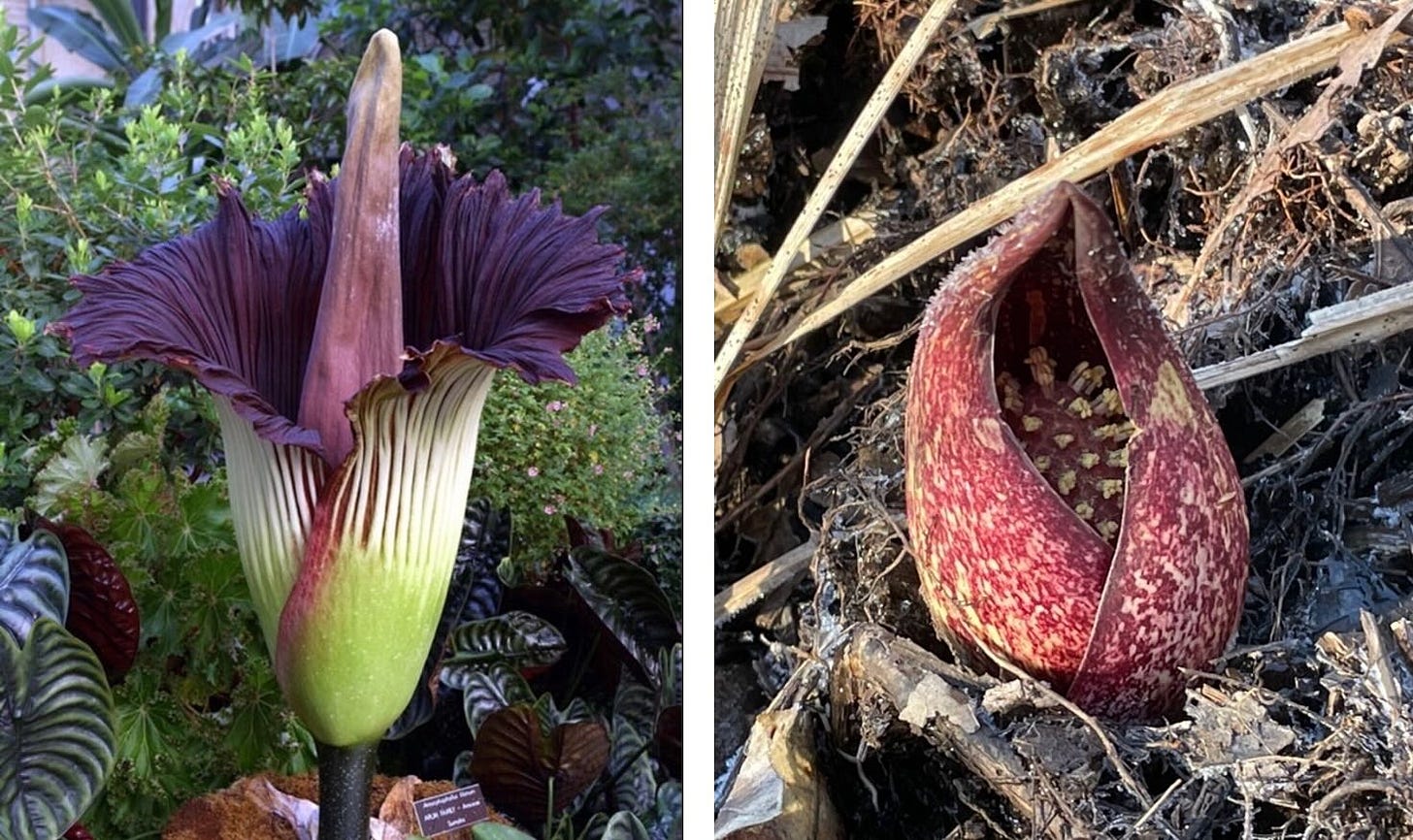
Flower Morphology and Female Anatomy
From the moment I first saw this remarkable bloom, I thought it resembled a kind of earthy vulva, housing the spongy reproductive flower of this underworld plant. This is a vividly literal image of rebirth in Spring: a plant that emerges from the depth of fertile soil with a form that resembles external female genitalia.
Most of the plants in the Araceae family, do not have a flower that is hidden within the folds of a hood, like Skunk Cabbage. Many of them have a prominently obvious protrusion that is commonly identified as penis-like. I find it disappointingly predictable that the plants that sport long and obvious flower protrusions which are easily visible without peering into a small cave, are unabashedly referred to as phallic, but in a search to find descriptive anatomical comparisons for Skunk Cabbage flowers, there was no mention of anything close to female genitalia, though it seems obvious to me and a few others I know. Just gaze for a minute at the photos above . . .
My comparison of Skunk Cabbage flowers with female anatomy isn’t a unique observation in flower morphology. Flowers are the reproductive organs for the plants that have them. The 20th Century painter, Georgia O’Keefe, is famous for her richly colored and vividly magnified paintings of flowers. She often deflected comments about the colorful images that were evocative of female genitalia blossoming in her sensual renderings. In her body of work, there are several studies of Skunk Cabbage blossoms, painted in the mid to late 1920s. I’ve included one below that she made in 1927. Do you see it?
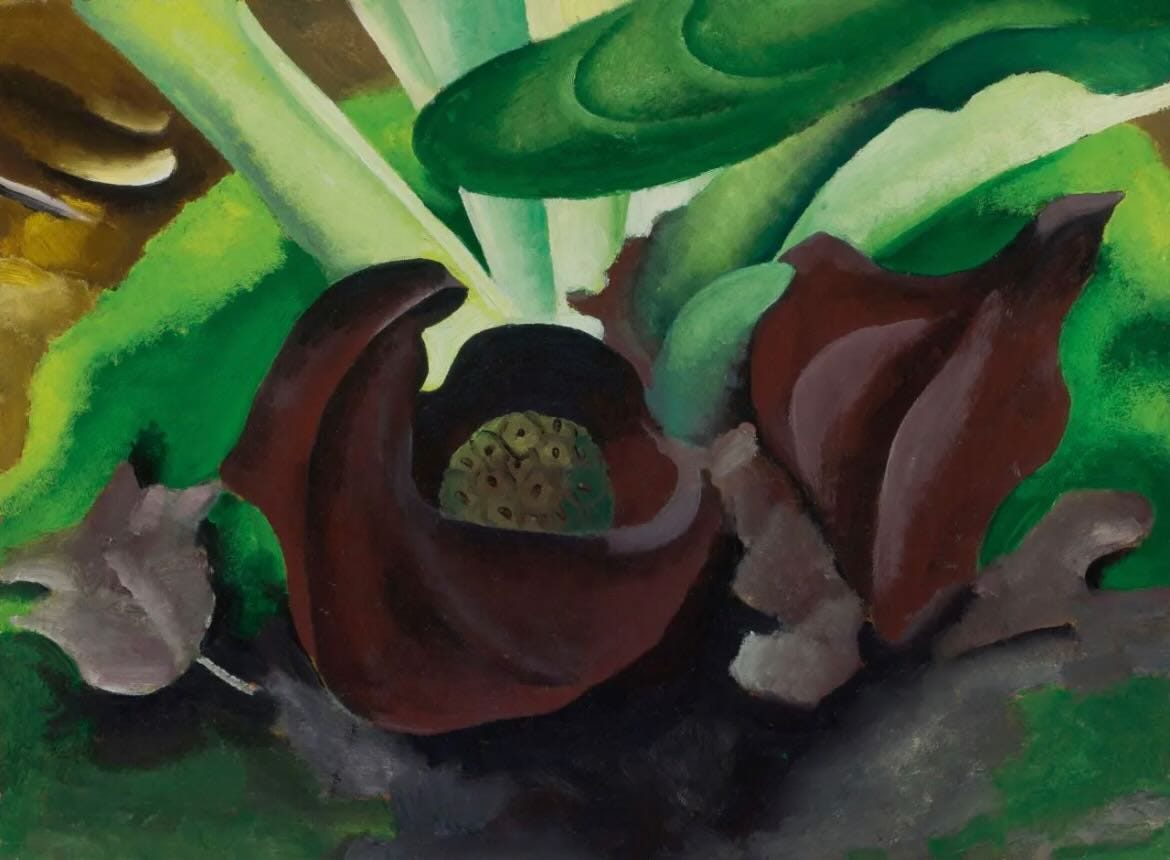
I use the word vulvar here with no hesitation to describe the Skunk Cabbage flowering structure, and I celebrate that this earthy plant in part resembles female genitalia, an organ through which most of us mammals must pass through on our way into life. A gateway for the womb that is sacred, not profane. Symbolically, the Skunk Cabbage is a kind of vulvar gateway for the womb of earth as the vernal pulse truly begins there in our woody wetlands.
A Profusion of Green
The spathe and spadix form the first bud that opens in late winter, but this plant also has a generous, green leaf bud right next to the flower bud. All of the young leaves for each plant grow curled in one tight spiral, curled around one another. As spring advances into April, the plant becomes a profusion of brilliant green as they unfurl. The leaves splay out in each direction rising gracefully into the air above the flower. The outer leaves can grow to 4 feet in length. Craig Holdrege, a person who spent time over six years observing and learning about this plant, described its leafing out as an “archetypal process of unfolding” because of the spiraling way they are packed into the bud and then loosen and unspiral together as they open and grow outward.
The leaves are very high in calcium oxalate crystals which, if eaten raw are poisonous and can cause severe pain in mouth, throat and stomach. Indigenous peoples did utilize them medicinally and nutritionally as an early forageable plant, but processed them thoroughly by drying and boiling to reduce the poison and ate only the cooked early leaf buds and carefully processed starchy roots.
Only a few animals eat them: snails love their leaves; muskrats, snapping turtles and wild turkeys like their buds; and black bear consume a large quantity of them when they emerge from hibernation, possibly as a regulating purgative to get the digestive system going again. This is so common that Skunk Cabbage is also known as “Bear Medicine”.
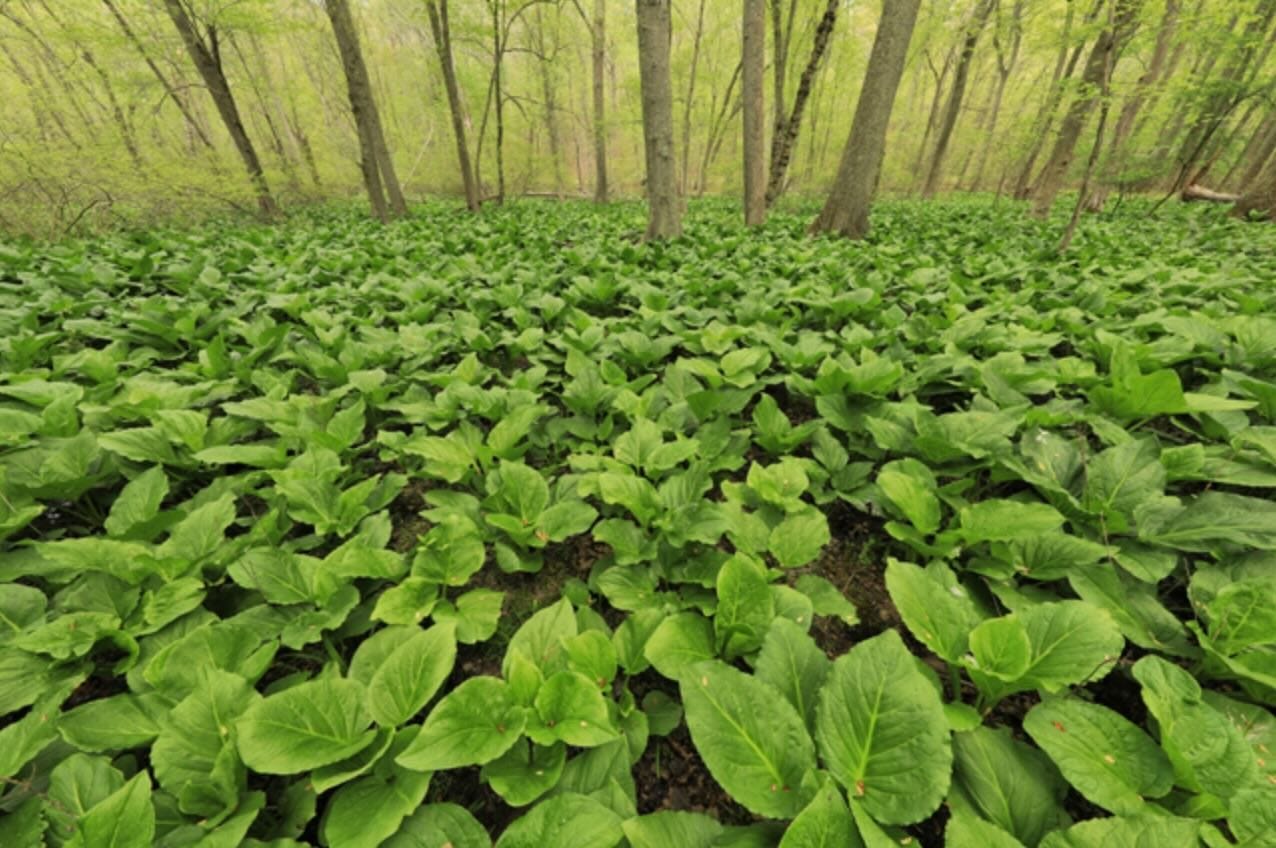
This plant is not fibrous. The leaves, spathe and flower are mostly watery and soft, and have no tough or waxy structure to limit water vapor from rising out of the leaf. This tender structure of the leaves enables the water that flows out of the soil and into the plant to freely rise out into the air through the leaves. This increases the humidity of the wetland and seasonally over-wet soil at the edges of wetland areas.
Return to the Underworld
After pollination, the egg-like internal flowerhead swells and grows into a compound fruit, like a large berry. As it swells in early summer, the spathe wilts and draws away to expose the fruit. The stem grows a bit longer, just enough for the fruit to gently lower to the ground. At the same time the leaves begin to die back, first opening horizontally outward in a whorl, and then slowly sinking to the ground where they break down quickly into a mush.
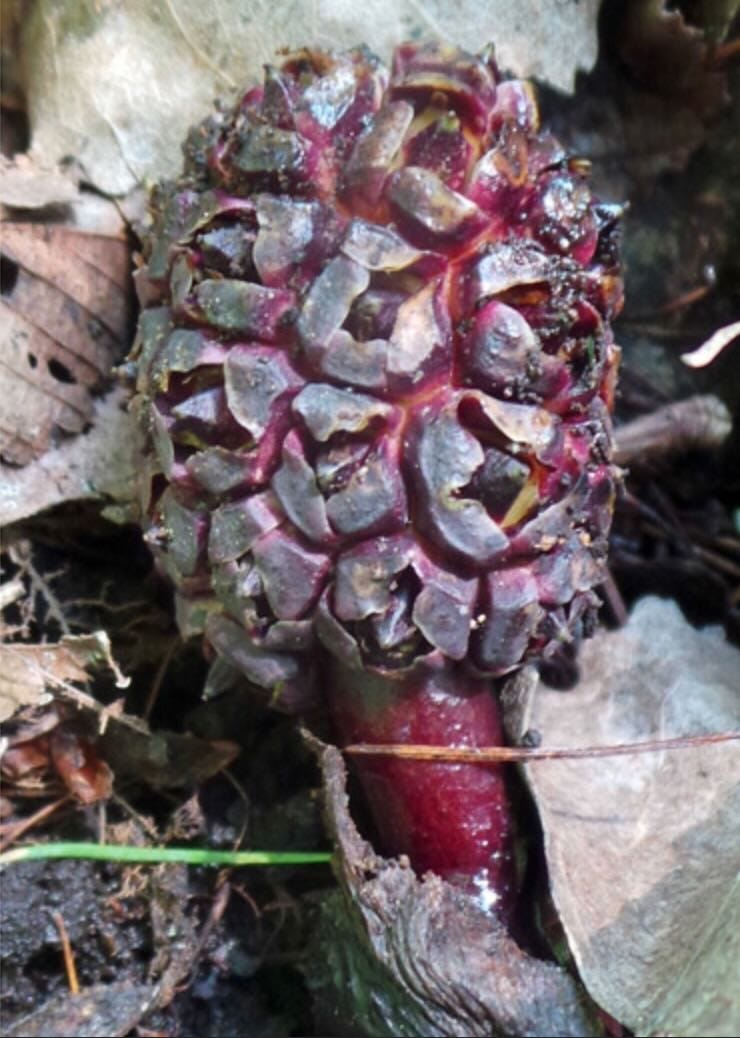
As the fruit ripens, its segments separate. They are eaten by wildlife or sink into the wet ground so the seeds can become new plants. By mid-summer there’s little left to see of the plant but the small buds of what will be next year’s growth at the top of the underground stem.
Skunk Cabbage has no taproot. The roots grow in a thick, mass that gets larger and deeper as the plant passes through the years. This large root mass helps to hold wetland soils in place. The dense roots are strong and possess the ability to contract and actually draw the plant downward. At the end of each yearly growth cycle, the roots do just that, pulling the underground stem of the plant downward so that each successive year the plant grows deeper and the roots more massive.
Within the underground stem, are a series of future buds, each set of flower and leaf buds develop there, waiting for their turn to rise to the surface. All through the late summer, fall and most of the winter, Skunk Cabbage will wait in the dark womb of the earth to be born once again in late winter.
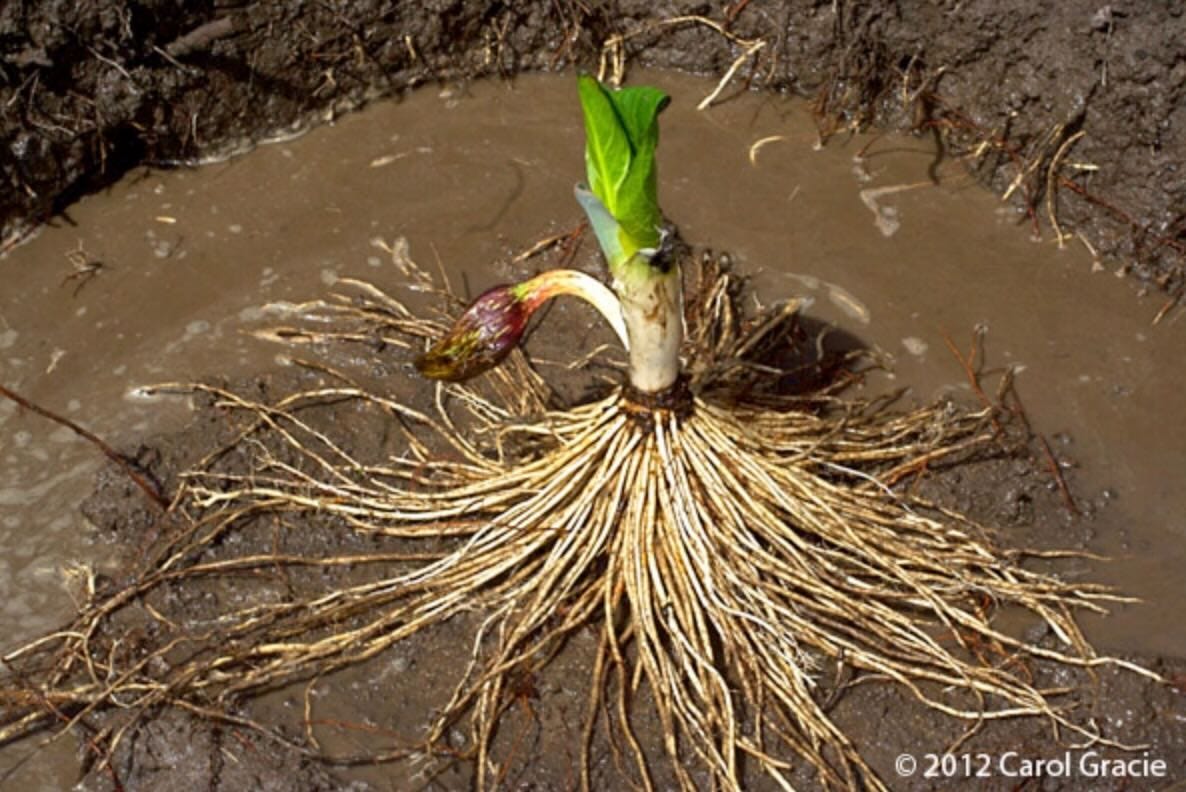
Life and Home
Nobody seems to really know exactly how long Skunk Cabbage can live. Estimates vary wildly from 20 to 2000 years. Their limiting factor is available habitat, which is impacted by the ways of humans and also natural ecosystem succession. Tree leaves and woody materials gradually fall and fill a wetland in a century or two. Human development encroaches.
I live in Michigan, a state name derived from the Ojibwe word, michigami, which means “large water.” This is a very watery place, surrounded by vast, inland unsalted seas that hold 20% of the world’s fresh surface water. The Great Lakes/St. Lawrence Basin is the largest watershed system in the world, with myriad inland lakes and streams. My area of southern Michigan was orginally a place of lake plains, swamps, marshes, wet meadows, bogs, fens and oak savannas, and the vast tracts of mixed hardwood forests that covered the higher glacial terrain.
When I think of the uncountable multitude of wetlands here that were drained, diverted and filled in by European colonial settlers to become farmland and new towns in the Great Lakes area, I feel a deep sense of loss and remorse at the ecological destruction of all those wetland places. It’s no wonder that as we continue to grow in population and urban/suburban sprawl, flooding has become a more frequent problem for us.
Countless wetland areas have been filled and repurposed all over the industrial world. Globally, wetland habitats are perilously threatened. They’re essential for water purification and flood control, and they are home to a vast diversity of creatures, like Skunk Cabbage, that can live nowhere else.
Skunk Cabbage as Mirror
Our lives are more meaningful when we strengthen connections and kinship with other beings. Knowing Skunk Cabbage, or other kinds of lives, is one way to begin to care about our earthly neighbors who we might not have known before. Appreciating their ways might even provide a kind of mirror, inviting us to consider our own lives.
I feel a human connection to Skunk Cabbage when I think of how people grow deeper over time. All through our lives we have periods of darkness or withdrawal, and opportunities for renewal and rebirth. I love the image of all the future selves of the Skunk Cabbage being cued up and ready to rise when the time is right. We too contain latent aspects of ourselves, folded like future buds that may be born and grow when the conditions are present and we’re ready and rooted for a new unfurling.
Skunk Cabbage is one of our wise elders. Their above-ground phase of life is brief, but while they grow and engage in the continuance of their own species on the ground’s surface, they not only seek what they need, they also contribute to the thriving of others who are not like themselves.
This is something for us as ground dwelling human creatures, to contemplate.
Note: A creature is a living being, one that is enlivened (“created”) through a kind of Holy Mystery that is evident in the spark of every life. Therefore, my use of the word “creature” applies to all the living: all microbes, protozoa, fungi, plants and animals. Each individual creature is a subject in its own life; therefore, I will always recognize that reality by referring to them as beings not as things.
Sources:
Calyx. “Ode to Skunk Cabbage: Lessons from the Swamp,” Northern Appalachia School (April 14, 2020; updated May 2, 2021). Accessed 3/8/24.
Holdrege, Craig. “Skunk Cabbage (Symplocarpus foetidus),” In Conext #4 (Fall 2000), The Nature Institute. Accessed 3/8/24
Lawson, Nancy. “The Magic of Skunk Cabbage: A Plant for the Ages,” The Humane Gardener (January 22, 2015). Accessed 3/8/24

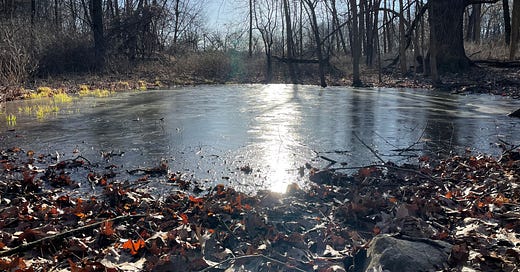



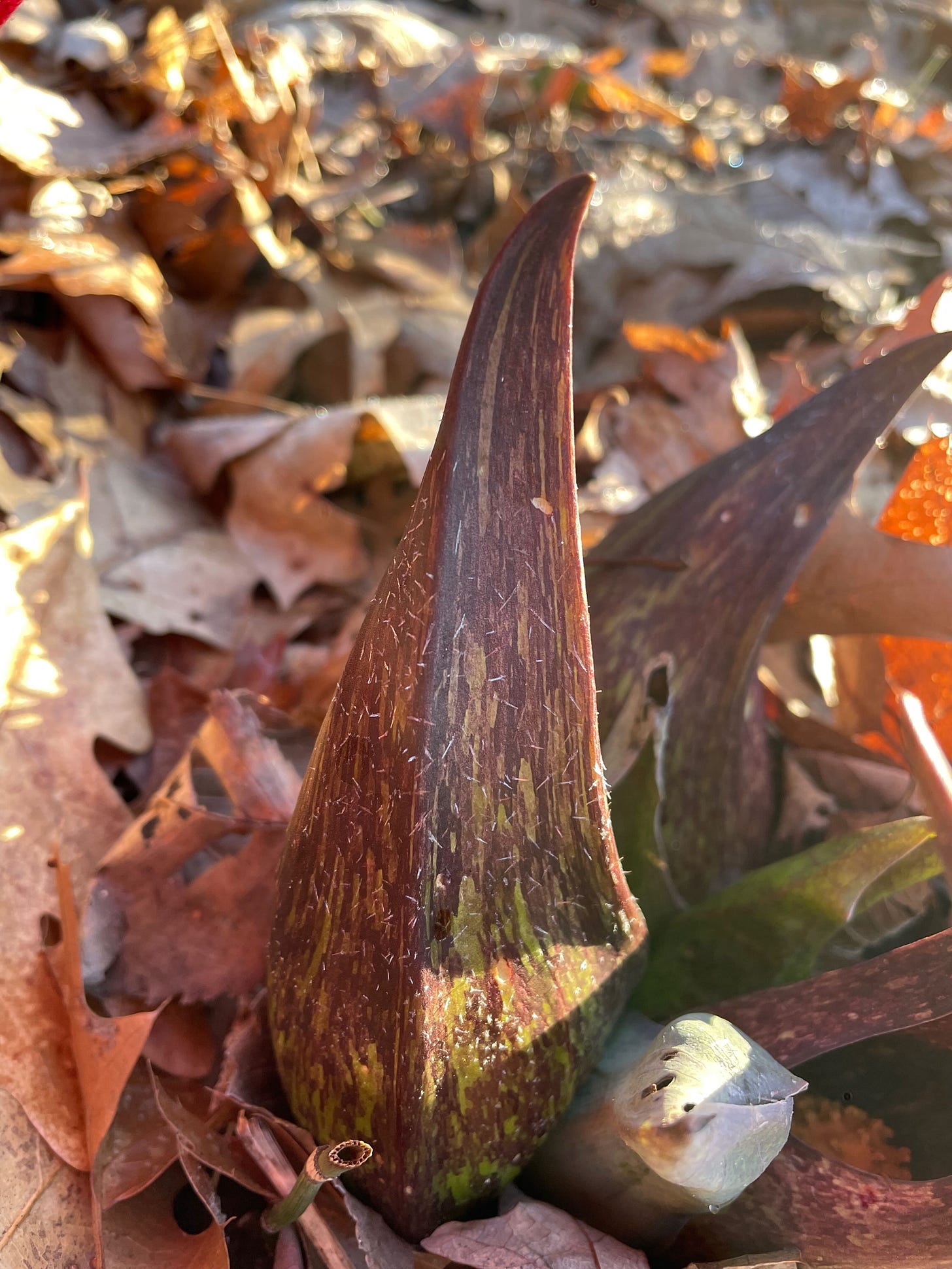
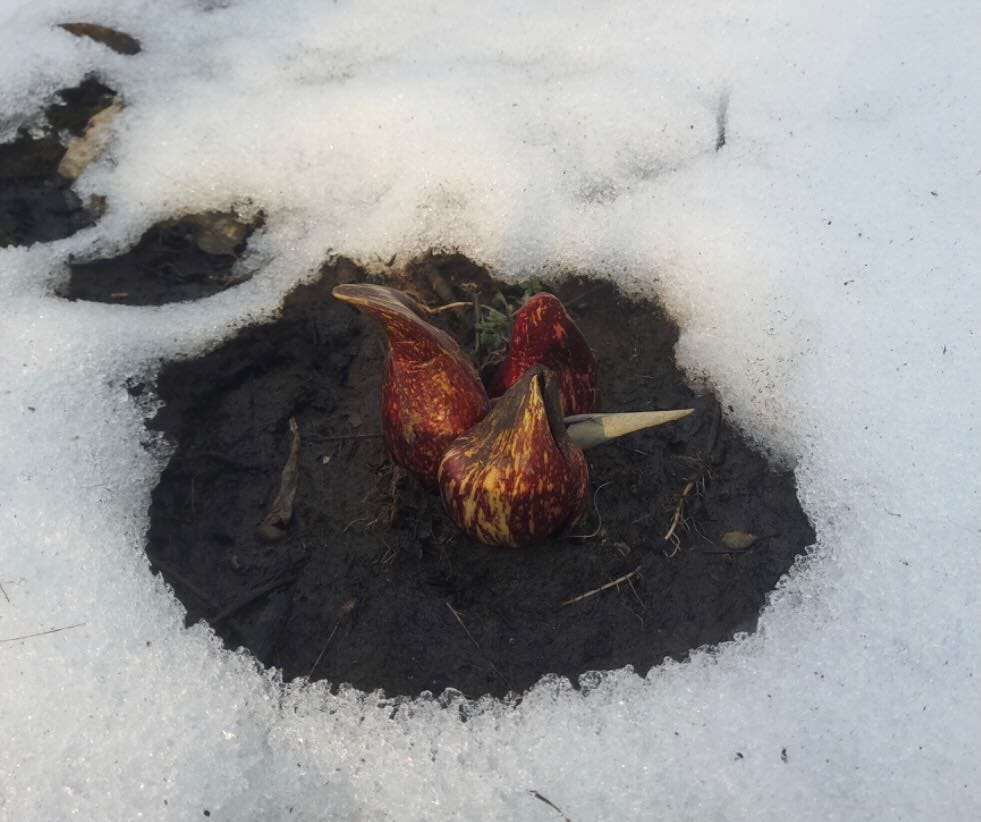
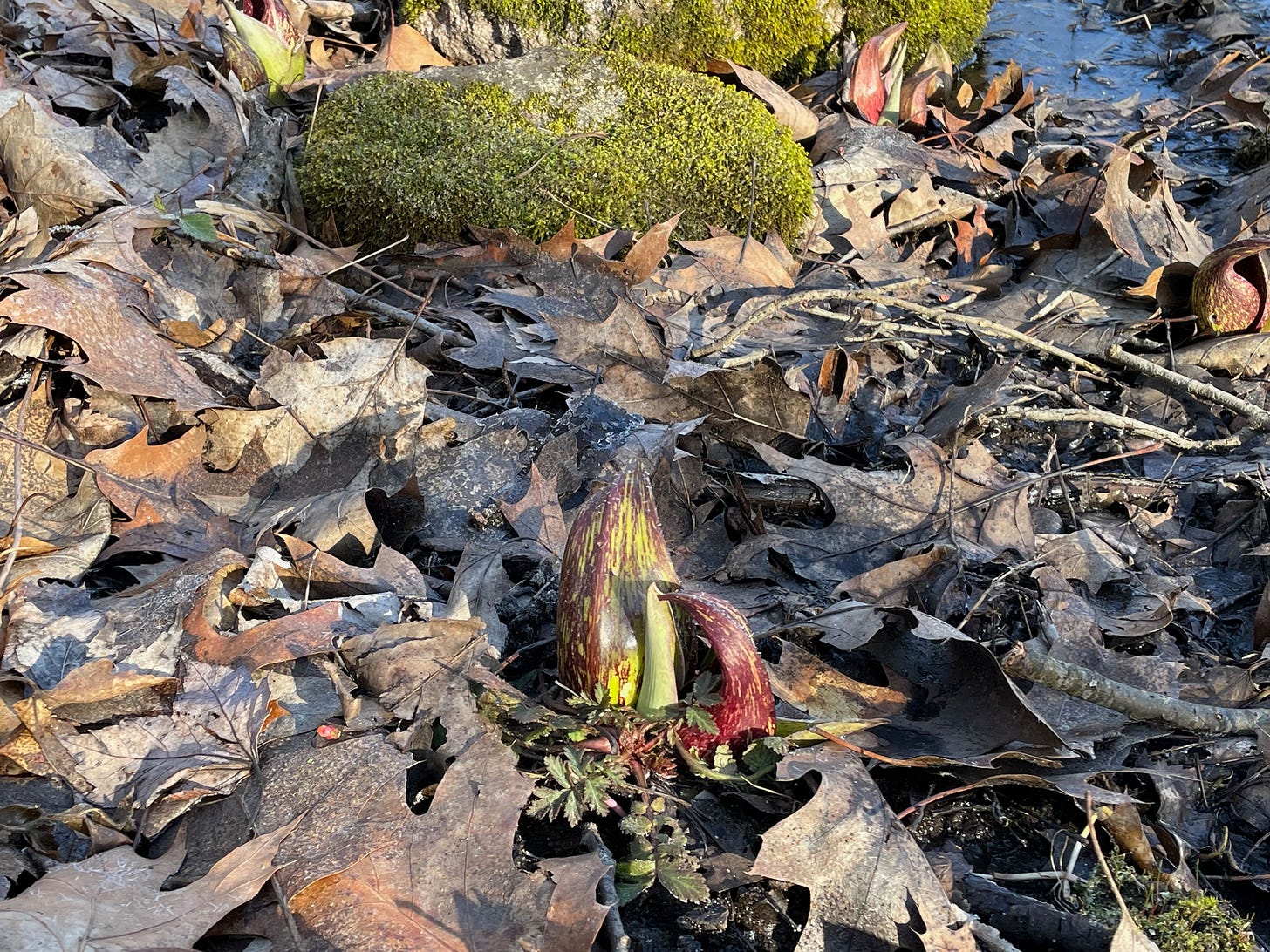
Thanks for reposting this, Michelle. A truly fascinating story. I shall look more closely in the Scandinavian woods for their own special signs of Spring. This weekend I’ll be spending in the Estonian forests…
P.S. I had already come across Craig Holdrege (and his work on the skunk cabbage) because of his link to Goethean science.
What a beautiful way to "awaken" my youthful memories of walking through areas of damp lowlands and grassy fields that were available to a youngster as he went out about his day exploring! "Go outside and play.. it's a nice day", was my permission slip to roam about and sometimes return with muddy shoes and wet pantlegs to my mother's queries of "where have your travels taken you, this time? Let's get those wet shoes and socks off...unroll those cuffs and shake of the dirt and mud OUTSIDE; before you come back into this house and get cleaned up... AGAIN!"
My mother's exasperation was short lived as I almost always brought her back something just for her from my journey. Brings tears to my eyes thinking of what a kind soul she had, allowing me to explore Earth's treasures with the wide eyes of youth, discovering something new each and every time I went out "exploring".
I hope her gentleness and kindness are genetic traits allow me to appreciate the beauty that this good Earth still provides, if we just allow ourselves the time to slowly walk and observe. Thank you for a beautiful presentation, Michelle.